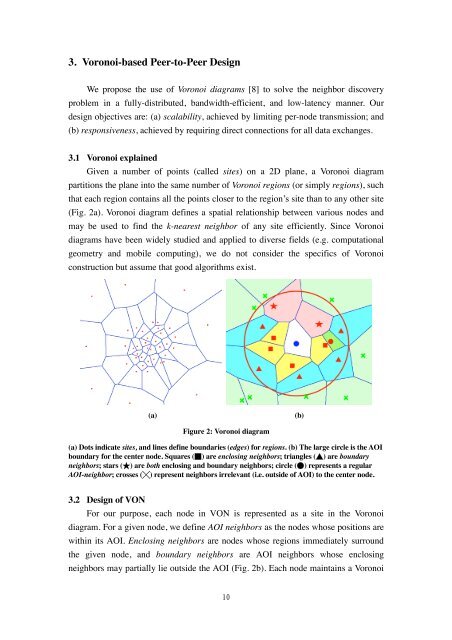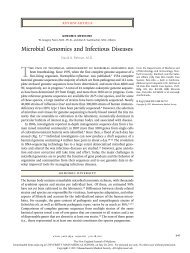A Scalable Peer-to-Peer Network for Virtual Environments - Evernote
A Scalable Peer-to-Peer Network for Virtual Environments - Evernote
A Scalable Peer-to-Peer Network for Virtual Environments - Evernote
You also want an ePaper? Increase the reach of your titles
YUMPU automatically turns print PDFs into web optimized ePapers that Google loves.
3. Voronoi-based <strong>Peer</strong>-<strong>to</strong>-<strong>Peer</strong> Design<br />
We propose the use of Voronoi diagrams [8] <strong>to</strong> solve the neighbor discovery<br />
problem in a fully-distributed, bandwidth-efficient, and low-latency manner. Our<br />
design objectives are: (a) scalability, achieved by limiting per-node transmission; and<br />
(b) responsiveness, achieved by requiring direct connections <strong>for</strong> all data exchanges.<br />
3.1 Voronoi explained<br />
Given a number of points (called sites) on a 2D plane, a Voronoi diagram<br />
partitions the plane in<strong>to</strong> the same number of Voronoi regions (or simply regions), such<br />
that each region contains all the points closer <strong>to</strong> the region)*+site than <strong>to</strong> any other site<br />
(Fig. 2a). Voronoi diagram defines a spatial relationship between various nodes and<br />
may be used <strong>to</strong> find the k-nearest neighbor of any site efficiently. Since Voronoi<br />
diagrams have been widely studied and applied <strong>to</strong> diverse fields (e.g. computational<br />
geometry and mobile computing), we do not consider the specifics of Voronoi<br />
construction but assume that good algorithms exist.<br />
(a) (b)<br />
Figure 2: Voronoi diagram<br />
(a) Dots indicate sites, and lines define boundaries (edges) <strong>for</strong> regions. (b) The large circle is the AOI<br />
boundary <strong>for</strong> the center node. Squares (!) are enclosing neighbors; triangles (") are boundary<br />
neighbors; stars (#) are both enclosing and boundary neighbors; circle ($) represents a regular<br />
AOI-neighbor; crosses (%) represent neighbors irrelevant (i.e. outside of AOI) <strong>to</strong> the center node.<br />
3.2 Design of VON<br />
For our purpose, each node in VON is represented as a site in the Voronoi<br />
diagram. For a given node, we define AOI neighbors as the nodes whose positions are<br />
within its AOI. Enclosing neighbors are nodes whose regions immediately surround<br />
the given node, and boundary neighbors are AOI neighbors whose enclosing<br />
neighbors may partially lie outside the AOI (Fig. 2b). Each node maintains a Voronoi<br />
!*
















